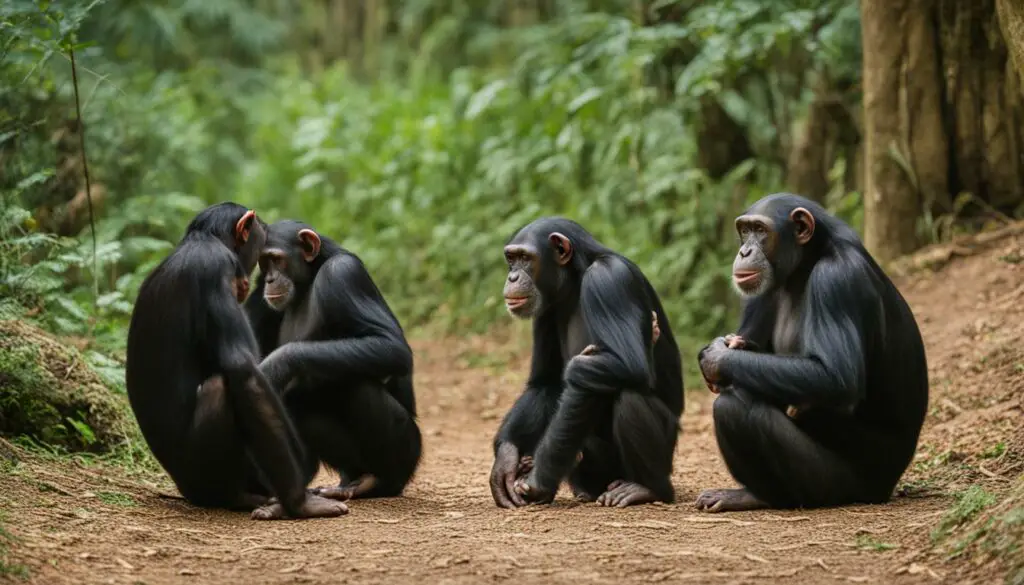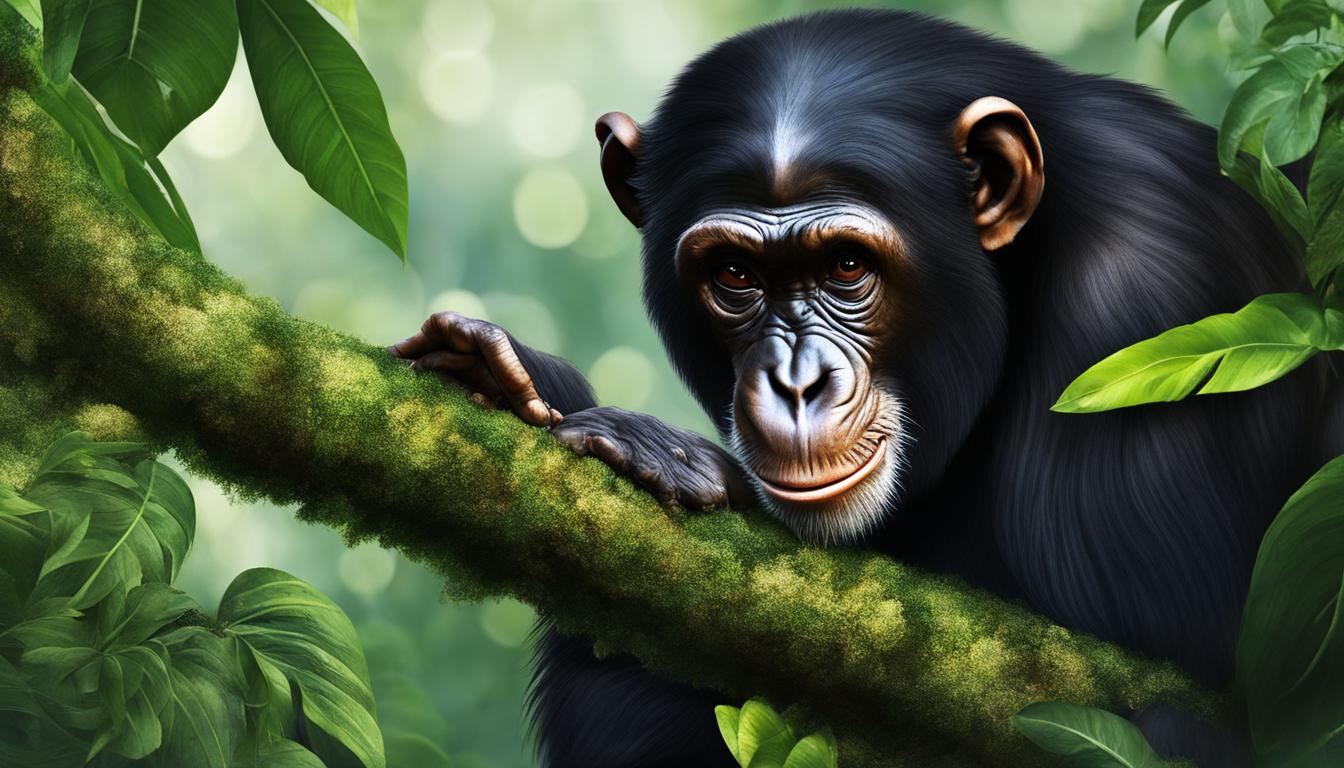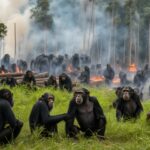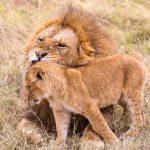When it comes to the average lifespan of chimpanzees in the wild, there are several factors to consider. A 20-year demographic study conducted in Uganda’s Kibale National Park provides valuable insights into the lifespan of these fascinating primates. The study revealed that the average lifespan of wild chimpanzees is approximately 33 years, which is nearly twice as high as other chimpanzee communities.
Interestingly, the average lifespan of wild chimpanzees falls within the range of life expectancy at birth for human hunter-gatherers. The researchers attribute the higher life expectancy of the Ngogo chimpanzees in Kibale to favorable ecological conditions. These conditions include a consistent supply of high-energy and nutritious food, as well as a low risk of predation.
Understanding the average lifespan of chimpanzees in the wild is critical for their care and conservation. It helps in planning for sanctuary capacity, managing captive populations, and implementing effective conservation efforts to protect these incredible creatures in their natural habitats.
Factors influencing chimpanzee lifespan in the wild
The lifespan of chimpanzees in the wild is influenced by various ecological factors that contribute to their overall health and survival. These factors play a significant role in determining the life expectancy of wild chimpanzees and understanding their population dynamics.
Food Supply: A consistent and abundant supply of high-energy and nutritious foods is essential for the well-being and longevity of wild chimpanzees. The availability of food resources directly impacts their nutritional status, energy levels, and ability to fight off diseases. In particular, fruits such as figs, which are rich in calories and essential nutrients, contribute significantly to their diet and overall health.
Predation: The risk of predation is another crucial factor affecting the lifespan of wild chimpanzees. Natural predators such as leopards and large snakes pose a constant threat to their survival. Chimpanzees living in areas with a lower risk of predation have a higher chance of reaching old age compared to those in regions with a higher predation risk.
Disease Epidemics: Disease outbreaks can have a devastating impact on wild chimpanzee populations. The spread of infectious diseases, such as Ebola and respiratory viruses, can cause high mortality rates among chimpanzees. Communities living in areas with fewer disease epidemics tend to have longer lifespans compared to those facing regular outbreaks.
By understanding these factors, researchers and conservationists can work towards protecting the natural habitats of chimpanzees and implementing conservation strategies that promote their long-term survival. It is crucial to ensure a sustainable food supply, minimize predation risks, and manage disease outbreaks effectively to support healthy chimpanzee populations in the wild.
Comparison of Lifespan between Captive and Wild Chimpanzees
Captive chimpanzees have a shorter lifespan compared to their wild counterparts. On average, captive males live up to 32.5 years, while captive females have an average lifespan of 40.1 years. In contrast, wild chimpanzees have an average lifespan of 33 years, with some individuals living longer.
It’s important to note that these figures represent average ages and don’t apply to every individual chimpanzee. Factors such as captivity conditions and the presence of natural predators can significantly influence the lifespan of chimpanzees in different settings.
Unlike their captive counterparts, wild chimpanzees face a dynamic environment that includes hunting for food, evading predators, and dealing with disease outbreaks. These challenges can impact their lifespan and contribute to individual variations among wild chimpanzees.
Although captive environments aim to provide care and protection, they may not fully replicate the natural conditions that contribute to the longevity of wild chimpanzees. The ability to forage for a varied diet, engage in social behaviors, and experience a more natural habitat are crucial factors that influence the lifespan of wild chimpanzees.
Efforts to enhance the living conditions of captive chimpanzees, such as providing opportunities for physical and mental stimulation, can contribute to improving their overall well-being and potentially extend their lifespan.
Keep in mind that the information provided is based on averages, and individual chimpanzees can exceed or fall short of these lifespans. Every chimpanzee’s journey is unique, and their health and longevity are influenced by a combination of genetic, environmental, and chance factors.
| Chimpanzee Group | Gender | Average Lifespan |
|---|---|---|
| Captive | Males | 32.5 years |
| Captive | Females | 40.1 years |
| Wild | Both | 33 years (on average) |

Variability in wild chimpanzee lifespans
While the average lifespan of wild chimpanzees is around 33 years, there is variability among individuals. Understanding this variability provides valuable insights into the factors influencing the lifespans of these fascinating primates.
Food availability: One crucial factor that affects wild chimpanzee lifespans is the availability of food. Chimpanzees rely on a diverse diet consisting of fruits, nuts, leaves, and even meat. The abundance and nutritional quality of their food sources play a significant role in their overall health and longevity.
Predation risk: Another factor impacting chimpanzee lifespans is the risk of predation. Predators such as leopards and humans pose a threat to their survival. Chimpanzees living in areas with lower predation risk tend to have longer lifespans compared to those in high-risk areas.
Disease epidemics: Disease outbreaks can have devastating effects on wild chimpanzee populations. Infectious diseases, such as Ebola, have led to high mortality rates among chimpanzees. The presence or absence of disease epidemics can significantly influence chimpanzee lifespans.
The variability in wild chimpanzee lifespans highlights the complex interactions between ecological factors and individual life histories. Different study sites have reported varying life expectancies for wild chimpanzees, illustrating the diversity of chimpanzee populations and their unique circumstances.
The oldest known wild chimpanzee was estimated to be approximately 63 years old when she passed away, demonstrating the potential for chimpanzees to live well beyond the average lifespan. This finding challenges previous assumptions about their longevity.
The following table provides a comparison of wild chimpanzee lifespans across different study sites:
| Study Site | Average Lifespan |
|---|---|
| Kibale National Park (Ngogo community) | 33 years |
| Taï National Park | 29 years |
| Mahale Mountains National Park | 35 years |
These variations in lifespan highlight the complex interplay between ecological factors, genetics, and individual circumstances that shape the lives of wild chimpanzees. Further research is essential to uncover the specific mechanisms behind these differences and to inform conservation efforts aimed at preserving the remarkable biodiversity of wild chimpanzee populations.
Implications for Chimpanzee Care and Conservation
Understanding the lifespan of chimpanzees in different settings, including the wild and captivity, is crucial for providing appropriate care and planning for the future. By knowing the average lifespans of these incredible primates, we can make informed decisions when it comes to chimpanzee care and conservation efforts.
One significant implication is in the management of captive chimpanzee populations. With knowledge of average lifespans, sanctuary capacity planning becomes more accurate. It allows us to predict the number of chimpanzees that will need care throughout their lifetime, ensuring sufficient resources and facilities are provided. This information is essential because sanctuary capacity is directly linked to the well-being and long-term care of captive chimpanzees.
Realistic expectations for chimpanzee lifespans are also crucial in providing the best possible care. Chimpanzees in captivity experience changing conditions compared to their wild counterparts, which can affect their overall well-being. By understanding the average lifespans of captive chimpanzees, caretakers can ensure appropriate care is provided at each stage of their lives, considering factors such as aging, potential health issues, and social needs.
Furthermore, the data on chimpanzee lifespans plays a vital role in informing conservation efforts. By understanding the average lifespan of chimpanzees in the wild, conservationists can develop strategies to protect these incredible primates and their habitats. It guides management practices, allowing us to create effective conservation plans that focus on preserving chimpanzee populations and ensuring their long-term survival in their natural environment.
Do Chimpanzees and Cheetahs Have Similar Lifespans in the Wild?
Chimpanzees and cheetahs have significantly different lifespans in the wild. Chimpanzees can live up to 40-50 years, while cheetahs have a shorter lifespan of 10-12 years. Despite their impressive cheetahs climbing abilities, they face numerous challenges in the wild that impact their longevity.
Does the decreasing population of gorillas have an impact on the lifespan of chimpanzees in the wild?
The decreasing gorilla population in the wild has potential impacts on chimpanzees’ lifespan. Gorillas and chimpanzees share an ecosystem and compete for resources. Declining gorilla numbers may lead to changes in food availability and habitat, affecting the health and survival of chimpanzees.











